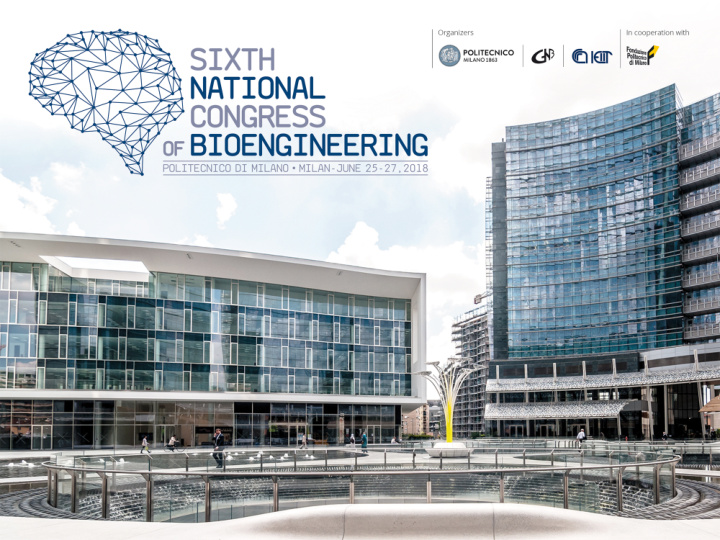



GNB 2018 The Congress is the melting pot among biomedical research and clinical end users fully inserted in the framework of the most advanced international research in bioengineering, which combines the engineering background with the clinical one. Held on a biannual base, it provides an overview of recent activities and breakthrough research in the field of Biomedical Engineering and aims at involving all members of the scientific and industrial communities: scientists, end users, stakeholders, entrepreneurs and startuppers in a win-win scenario. 1
TOPICS & STRUCTURE
TOPICS: OVERVIEW C UTTING EDGE D IGITAL RESEARCH FOR REVOLUTION OF ACTIVE AGEING BIG DATA FOR AND HEALTHY GENOMICS AND LIVING TRANSCRIPTOMICS F RONTIER R EGENERATIVE TECHNOLOGIES MEDICINE AND FOR HEALTH BIOROBOTICS 3
TOPICS 1. Cutting edge research for active ageing and healthy living This research represents one of the pillars of the societal challenge of the H2020 EU framework program oriented to counteract the population ageing of the western countries and the concurrent shortage of healthcare operators. It is a multidisciplinary research involving also key enabling technologies for industries working in the healthcare sector and in satellite activities. The main topics are those of early biomarkers detection, prevention and personalized precision treatment, with attention to allow home living with normal daily life activities. 4
TOPICS 2. Digital revolution of big data for genomics and transcriptomics Advancements in genomics and personalized medicine not only effect healthcare delivery from patient and provider standpoints, but also reshape biomedical discovery. We are in the era of the “-omics”, wherein an individual’s genome, transcriptome, proteome and metabolome can be scrutinized to the finest resolution to paint a personalized biochemical fingerprint that enables tailored treatments, prognoses, risk factors, etc. Digitization of this information parlays into “big data” informatics-driven evidence-based medical practice. 5
TOPICS 3. Regenerative medicine and biorobotics Replacement of a damaged organ is already made possible by artificial organs and devices (like hip, knee, heart valves, vascular stents, insulin pumps, dialysis, etc). But soon, we will be able to regenerate tissues by innovative bio-artificial products containing live cells. The product classes primarily addressed are dermatologic, wound care, musculo-skeletal and heart repair, neurologic repair and inflammatory disease (Crohn’s disease, arthritis). Innovation in this field is carried by frontier research in biomaterials, biomechanics and technologies for cell manipulation. We can also replace functional systems by robotic prostheses or robotic exoskeletons. Bioinspired miniaturized robots can also travel inside our body and perform diagnosis or repair tissue in a minimally invasive way. 6
TOPICS 4. Frontier technologies for health Biomedical engineering is pervasive and ubiquitous in health and in medicine. New engineering devices and new systems for health are daily designed and manufactured. In no other technical and scientific field the technological progress is so fast and promising. Frontier technologies of bioengineering are revolutionizing medicine and, hence health, impacting in areas such as, for example, brain and cognition, big data for health, computational biology and modelling, biomedical and health informatics, environmental health, sensors and systems. 7
STRUCTURE PROGRAM CHAIRS Giancarlo Ferrigno Full Professor, Department of Electronics, Information and Bioengineering (DEIB), Politecnico di Milano Manuela Raimondi, Associate Professor, Department of Chemistry, Materials and Chemical Engineering «Giulio Natta», Politecnico di Milano Paolo Ravazzani Director of Research, IEIIT, Consiglio Nazionale delle Ricerche, Milano 8
KEYNOTE LECTURES • Hans van Oosterwyck , Professor of Biomechanics, Katholieke Universiteit Leuven (Belgium) • Lena Maier-Hein , Professor and Doctor, Deutsches Krebsforschungszentrum - German Cancer Research Center, Heidelberg (Germany) • Paolo Bonato , Professor in the Department of Physical Medicine and Rehabilitation, Harvard Medical School; Director of the Motion Analysis Laboratory at Spaulding Rehabilitation Hospital, Boston (USA) 10
COMMUNICATION
TARGET AUDIENCE • Members of the scientific and industrial communities : scientists, stakeholders, entrepreneurs and startuppers • Early stage researchers (PhD students and post doc) • Clinical endusers In the last edition held in Naples in 2016, around 300 people attended the congress. 10
CAMPAIGN WEBSITE DEM BRAND IMAGE SOCIAL MEDIA MEDIA RELATION CAMPAIGN 2017 2018 WEBSITE WEBSITE SOCIAL MEDIA CAMPAIGN SOCIAL MEDIA CAMPAIGN (twitter/facebook) (twitter/facebook) BRAND IMAGE BRAND IMAGE DEM MEDIA RELATION 11
FOLLOW-UP Sponsors will receive a recap document with: • Facts & numbers • Detailed communication report (track records, analytics, insights, redemption rates) • Attendance list and audience analysis • Feedbacks & Evaluations 12
SUPPORTERS
SPONSORSHIP • Expand your network within the bioengineering and the clinical communities • Increase your exposure: logo visibility and communication campaign • Market your products • Confront with new ideas and novelties in the scientific world • Meet young, well prepared, talents in the field 14
BENEFITS Silver Gold Platinum • logo on the web site • logo on promotional • logo on promotional • logo on promotional material (e.g. flyers, material (e.g. flyers, material (e.g. flyers, banners, invitations etc.) banners, invitations etc.) banners, invitations etc.) • logo on conference • logo on conference • logo on conference proceedings proceedings proceedings • visibility in the • booth space • visibility in the communication campaign • visibility in the communication campaign (social media and PR) communication campaign (social media and PR) • booth space (social media and PR) • 1 free pass • 2 free pass • 4 free pass • round table discussion or € 2,500 + VAT € 5,000+ VAT award naming € 10,000+ VAT 15
ALTERNATIVE TECHNICAL / MEDIA SPONSORSHIP Professional contribution or ' in kind ‘ contribution: • technological support • communication support • catering • organization of the social dinner • transport, transfers and accommodation for speakers 16
TO KNOW MORE www.gnb2018.polimi.it EMAIL: gnb-2018@polimi.it Contact person: Monica Lancini Communications and External Relations Fondazione Politecnico di Milano P.zza L. Da Vinci 32, 20133 Milano monica.lancini@fondazione.polimi.it 02 2399 9156 17
Recommend
More recommend